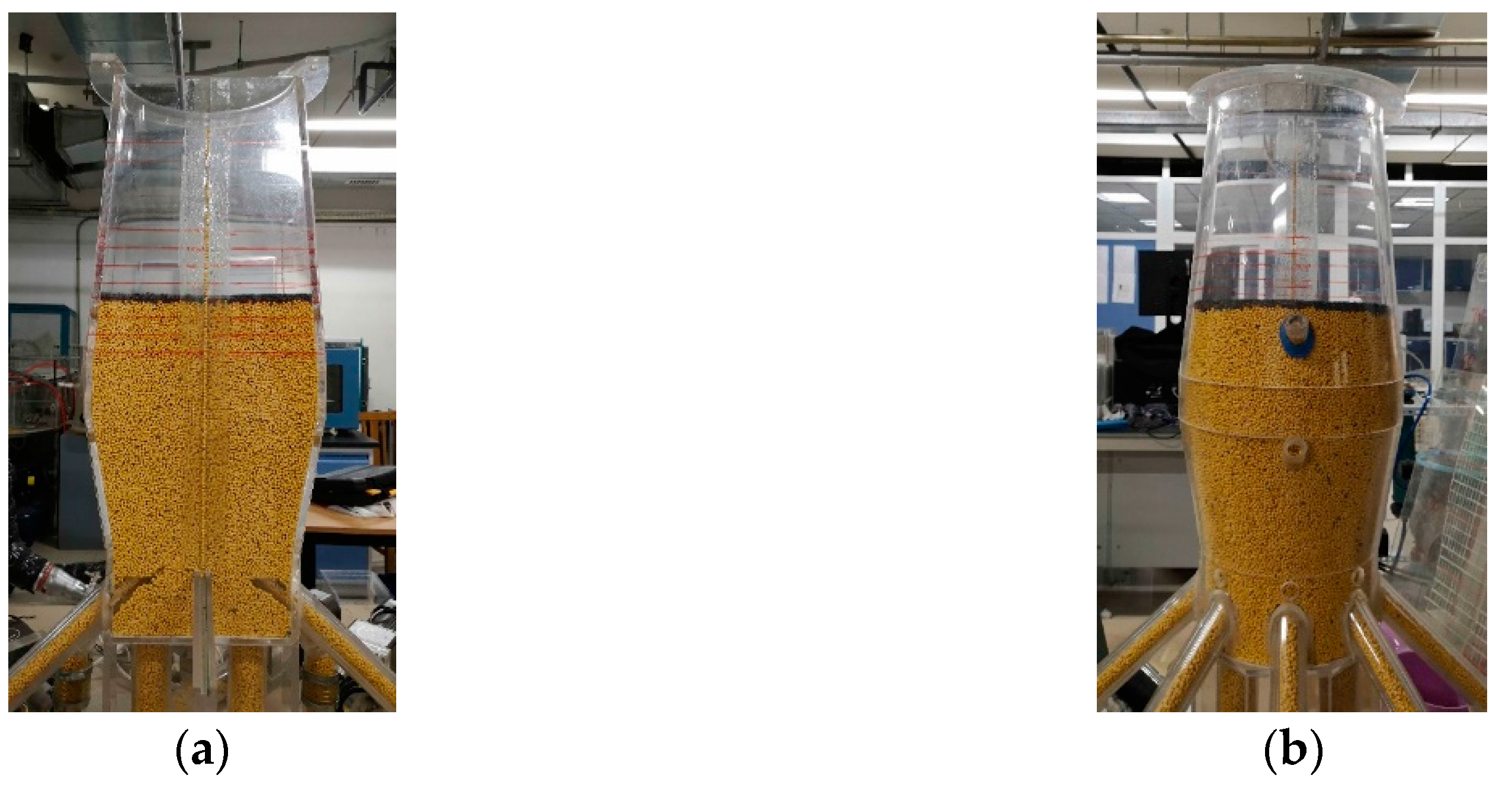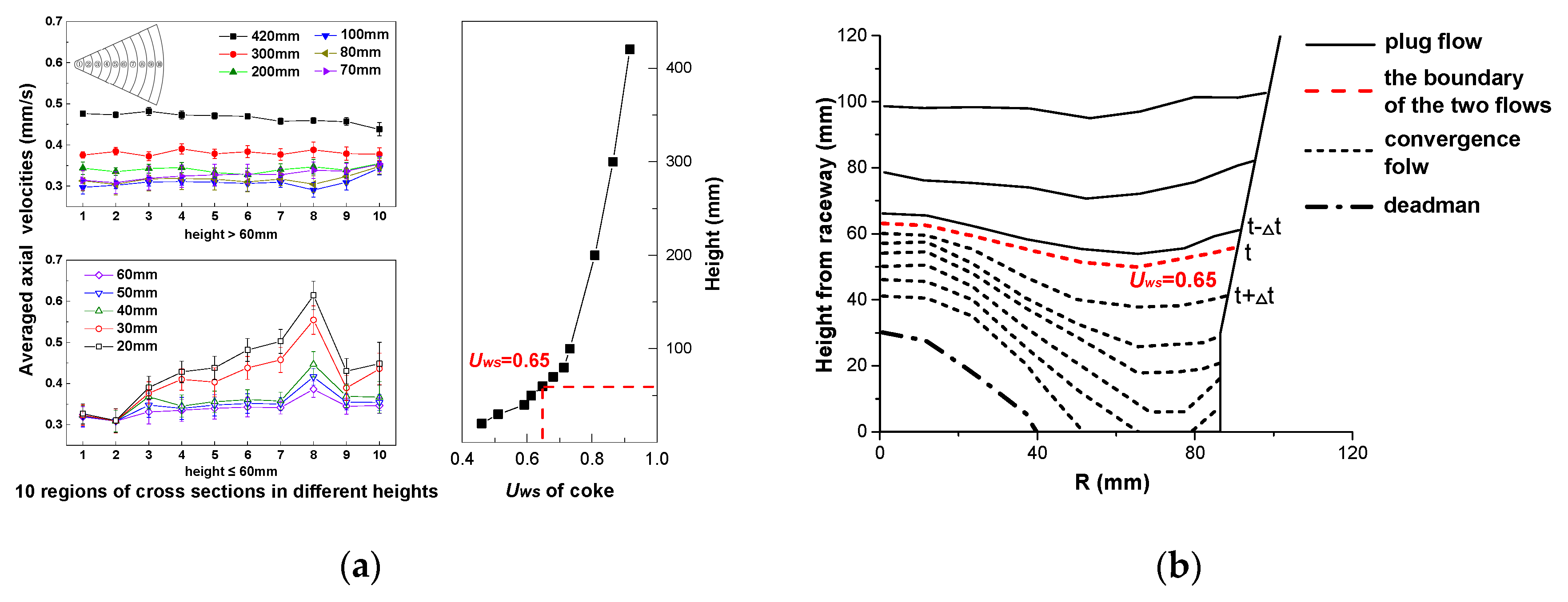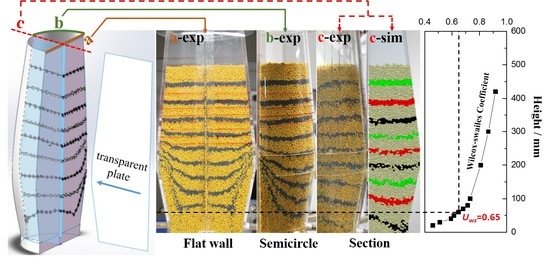Vertical Section Observation of the Solid Flow in a Blast Furnace with a Cutting Method
Abstract
:1. Introduction
2. Materials and Methods
2.1. Experimental Design
2.2. Experiment Setup
2.3. Particle Properties
2.4. Experimental Procedure
2.5. Discrete Element Method
3. Results
3.1. Vertical Section of the Solid Flow in the Experimental BF Model
3.2. Vertical Section of Solid Flow Under Different Burden Layer Conditions
3.3. The Boundary of the Plug Flow and Convergence Flow in BF
4. Conclusions
Author Contributions
Funding
Conflicts of Interest
Appendix A




References
- Yagi, J.-I. Mathematical modeling of the flow of four fluids in a packed bed. ISIJ Int. 1993, 33, 619–639. [Google Scholar] [CrossRef]
- Dong, X.; Yu, A.; Yagi, J.-I.; Zulli, P. Modelling of multiphase flow in a blast furnace: Recent developments and future work. ISIJ Int. 2007, 47, 1553–1570. [Google Scholar] [CrossRef]
- Ariyama, T.; Natsui, S.; Kon, T.; Ueda, S.; Kikuchi, S.; Nogami, H. Recent progress on advanced blast furnace mathematical models based on discrete method. ISIJ Int. 2014, 54, 1457–1471. [Google Scholar] [CrossRef]
- Kuang, S.B.; Li, Z.Y.; Yu, A.B. Review on modelling and simulation of blast furnace. Steel Res. Int. 2018, 89, 1700071. [Google Scholar] [CrossRef]
- Cundall, P.A.; Strack, O.D. A discrete numerical model for granular assemblies. Geotechnique 1979, 29, 47–65. [Google Scholar] [CrossRef]
- Ichida, M.; Nishihara, K.; Tamura, K.; Sugata, M.; Ono, H. Influence of ore/coke distribution on descending and melting behavior of burden in blast furnace. ISIJ Int. 1991, 31, 505–514. [Google Scholar] [CrossRef]
- An, X.-W.; Wang, J.-S.; Lan, R.-Z.; Han, Y.-H.; Xue, Q.-G. Softening and melting behavior of mixed burden for oxygen blast furnace. J. Iron Steel Res. Int. 2013, 20, 11–16. [Google Scholar] [CrossRef]
- Liu, J.; Xue, Q.; She, X.; Wang, J. Investigation on interface resistance between alternating layers in the upper of blast furnace. Powder Technol. 2013, 246, 73–81. [Google Scholar] [CrossRef]
- Fu, D.; Chen, Y.; Zhao, Y.; D’Alessio, J.; Ferron, K.J.; Zhou, C.Q. CFD modeling of multiphase reacting flow in blast furnace shaft with layered burden. Appl. Therm. Eng. 2014, 66, 298–308. [Google Scholar] [CrossRef]
- Natsui, S.; Ueda, S.; Fan, Z.; Andersson, N.; Kano, J.; Inoue, R.; Ariyama, T. Characteristics of solid flow and stress distribution including asymmetric phenomena in blast furnace analyzed by discrete element method. ISIJ Int. 2010, 50, 207–214. [Google Scholar] [CrossRef]
- Yang, W.; Zhou, Z.; Yu, A.; Pinson, D. Particle scale simulation of softening–melting behaviour of multiple layers of particles in a blast furnace cohesive zone. Powder Technol. 2015, 279, 134–145. [Google Scholar] [CrossRef]
- Yu, Y.; Saxén, H. Experimental and DEM study of segregation of ternary size particles in a blast furnace top bunker model. Chem. Eng. Sci. 2010, 65, 5237–5250. [Google Scholar] [CrossRef]
- Wu, S.; Kou, M.; Xu, J.; Guo, X.; Du, K.; Shen, W.; Sun, J. DEM simulation of particle size segregation behavior during charging into and discharging from a Paul-Wurth type hopper. Chem. Eng. Sci. 2013, 99, 314–323. [Google Scholar] [CrossRef]
- Dong, Z.; Wang, J.; Zuo, H.; She, X.; Xue, Q. Analysis of gas–solid flow and shaft-injected gas distribution in an oxygen blast furnace using a discrete element method and computational fluid dynamics coupled model. Particuology 2017, 32, 63–72. [Google Scholar] [CrossRef]
- Zhang, H.-J.; She, X.-F.; Han, Y.-H.; Wang, J.-S.; Zeng, F.-B.; Xue, Q.-G. Softening and Melting Behavior of Ferrous Burden under Simulated Oxygen Blast Furnace Condition. J. Iron Steel Res. Int. 2015, 22, 297–303. [Google Scholar] [CrossRef]
- Fan, Z.; Igarashi, S.; Natsui, S.; Ueda, S.; Yang, T.; Inoue, R.; Ariyama, T. Influence of blast furnace inner volume on solid flow and stress distribution by three dimensional discrete element method. ISIJ Int. 2010, 50, 1406–1412. [Google Scholar] [CrossRef]
- Samsu, J.; Zhou, Z.; Pinson, D. Flow and wall stress analysis of granular materials around blocks attached to a wall. Powder Technol. 2018, 330, 431–444. [Google Scholar] [CrossRef]
- Adema, A.T.; Yang, Y.; Boom, R. Discrete element method-computational fluid dynamic simulation of the materials flow in an iron-making blast furnace. ISIJ Int. 2010, 50, 954–961. [Google Scholar] [CrossRef]
- Ping, Z.; Shi, P.-Y.; Song, Y.-P.; Tang, K.-L.; Dong, F. Evaluation of burden descent model for burden distribution in blast furnace. J. Iron Steel Res. Int. 2016, 23, 765–771. [Google Scholar]
- Fu, D.; Chen, Y.; Zhou, C.Q. Mathematical modeling of blast furnace burden distribution with non-uniform descending speed. Appl. Math. Model. 2015, 39, 7554–7567. [Google Scholar] [CrossRef] [Green Version]
- Xu, B.; Yu, A.; Chew, S.; Zulli, P. Numerical simulation of the gas–solid flow in a bed with lateral gas blasting. Powder Technol. 2000, 109, 13–26. [Google Scholar] [CrossRef]
- Hou, Q.; Dianyu, E.; Kuang, S.; Li, Z.; Yu, A. DEM-based virtual experimental blast furnace: A quasi-steady state model. Powder Technol. 2017, 314, 557–566. [Google Scholar] [CrossRef]
- Khodak, L.Z.; Borisov, Y.I. Velocity and pressure distributions of moving granular materials in a model of a shalt kiln. Powder Technol. 1971, 4, 187–194. [Google Scholar] [CrossRef]
- Ho, C.-K.; Chen, Y.-M.; Lin, C.-I.; Jeng, J.-R. On the flow of granular material in a model blast furnace. Powder Technol. 1990, 63, 13–21. [Google Scholar] [CrossRef]
- Wright, B.; Zulli, P.; Zhou, Z.; Yu, A. Gas–solid flow in an ironmaking blast furnace—I: Physical modelling. Powder Technol. 2011, 208, 86–97. [Google Scholar] [CrossRef]
- Zhou, Z.; Zhu, H.; Wright, B.; Yu, A.; Zulli, P. Gas–solid flow in an ironmaking blast furnace-II: Discrete particle simulation. Powder Technol. 2011, 208, 72–85. [Google Scholar] [CrossRef]
- Yang, W.; Zhou, Z.; Yu, A. Discrete particle simulation of solid flow in a three-dimensional blast furnace sector model. Chem. Eng. J. 2015, 278, 339–352. [Google Scholar] [CrossRef]
- Johnson, K.J.C. Contact Mechanics; Cambridge University Press: Cambridge, UK, 1985. [Google Scholar]
- Jin, P.; Jiang, Z.; Bao, C.; Lu, Y.; Zhang, J.; Zhang, X. Mathematical modeling of the energy consumption and carbon emission for the oxygen blast furnace with top gas recycling. Steel Res. Int. 2016, 87, 320–329. [Google Scholar] [CrossRef]
- Mateos, L. Assessing whole-field uniformity of stationary sprinkler irrigation systems. Irrig. Sci. 1998, 18, 73–81. [Google Scholar] [CrossRef]
- Mateos, L. A simulation study of comparison of the evaluation procedures for three irrigation methods. Irrig. Sci. 2006, 25, 75–83. [Google Scholar] [CrossRef]
- Allaire-Leung, S.; Wu, L.; Mitchell, J.; Sanden, B. Nitrate leaching and soil nitrate content as affected by irrigation uniformity in a carrot field. Agric. Water Manag. 2001, 48, 37–50. [Google Scholar] [CrossRef]





| Parameters | Value |
|---|---|
| Diameter of hearth, m | 0.213 |
| Diameter of belly, m | 0.267 |
| Diameter of throat, m | 0.200 |
| Height of hearth, m | 0.213 |
| Height of bosh, m | 0.160 |
| Height of belly, m | 0.054 |
| Height of shaft, m | 0.333 |
| Height of throat, m | 0.100 |
| Forces and Torques | Symbols | Equations |
|---|---|---|
| Normal contact force | ||
| Normal damping force | ||
| Tangential contact force | ||
| Tangential damping force | ||
| Coulomb friction force | ||
| Torque by tangential forces | ||
| Rolling friction torque |
| Parameters | Sector Model 1 | Sector Model 2 |
|---|---|---|
| Particle shape | Spherical | Spherical |
| Particle motion state | Moving bed | Moving bed |
| Particle diameter, mm | 2.5 (c), 1.25 (o) | 2.5 (polyethylene) |
| Particle density, kg/m3 | 1100 (c), 4000 (o) | 910 (polyethylene) |
| Wall density, kg/m3 | 7600 (furnace wall) | 1200 (acrylic) |
| Time step, s | 1 × 10−4 | 1 × 10−4 |
| Total number | Variable | 35,000 |
| Poisson’s ratio | 0.21 (c), 0.24 (o) | 0.49 (polyethylene) |
| Shear modulus, Pa | 1e + 07 | 1e + 07 |
| Coefficient of restitution | 0.3 | 0.3 |
| Coefficient of interparticle static friction | 0.63 (c-c), 0.4 (c-o), 0.32 (o-o) | 0.21 |
| Coefficient of interparticle rolling friction | 0.05 | 0.05 |
| Coefficient of static friction (p - wall A) | 0 | 0 |
| Coefficient of static friction (p - wall B) | 0 | 0 |
| Coefficient of static friction (p - wall C) | 0 | 0.156 |
| Coefficient of static friction (p - wall D) | 0.56 (c-w), 0.31 (o-w) | 0.156 |
| Coefficient of rolling friction (p - w) | 0.05 | 0.05 |
© 2019 by the authors. Licensee MDPI, Basel, Switzerland. This article is an open access article distributed under the terms and conditions of the Creative Commons Attribution (CC BY) license (http://creativecommons.org/licenses/by/4.0/).
Share and Cite
Lu, Y.; Jiang, Z.; Zhang, X.; Wang, J.; Zhang, X. Vertical Section Observation of the Solid Flow in a Blast Furnace with a Cutting Method. Metals 2019, 9, 127. https://doi.org/10.3390/met9020127
Lu Y, Jiang Z, Zhang X, Wang J, Zhang X. Vertical Section Observation of the Solid Flow in a Blast Furnace with a Cutting Method. Metals. 2019; 9(2):127. https://doi.org/10.3390/met9020127
Chicago/Turabian StyleLu, Yuanxiang, Zeyi Jiang, Xinru Zhang, Jingsong Wang, and Xinxin Zhang. 2019. "Vertical Section Observation of the Solid Flow in a Blast Furnace with a Cutting Method" Metals 9, no. 2: 127. https://doi.org/10.3390/met9020127





